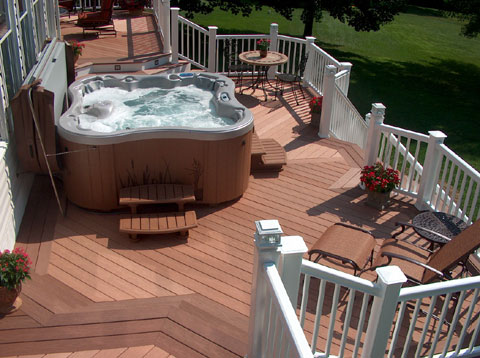New Capped Composite Decking Advances Again
What Do You Need To Know About Capped Composite Decking Boards?
The latest advancement in the composite deck category is the concept of capped boards. It's also called capstock decking.
These are essentially composite boards with a wood plastic core and a layer of textured plastic around the board.
This skin covers the top and sides and leaves the bottom side uncovered and free to breathe.
The Advantages
The concept of encasing the more vulnerable wood fiber plastic core makes good sense.
These durable skins are made to stand up to sun, staining, mold, bacteria and all kinds of other environmental predators.
They can be textured and colored which can create stunning visual effects. These are good elements that consumers have been looking for. But these great features come at a price. Some of the higher end capped composite decking can cost up to $4.50+ per foot range.
Some hardwoods can be purchased within this same price range and they are almost indestructible and they are the real deal! There is one hardwood that I really like.
The Disadvantages
Ends of boards could expand and mushroom.
In the early days of working with this material the boards were covered on all four sides, so the ends of the boards were mushrooming when they got wet. Imagine the wood core is like a straw and sucks in the moisture if the end gets wet but there is no where for the expansion pressure to escape, except out of the ends of the boards.
Many builders unfortunately experienced this in the very early days of working with this new material. It seemed that the more the board was encapsulated, the less it could expand if water was absorbed at the exposed ends. Consequently, there were some horror stories of boards expanding sideways at the ends that never went back to normal.
This is certainly why you will now see that capped composite decking always has an unsealed bottom and, usually, partially unsealed sides as well. Clearly, the attempt is to stop the expanding and mushrooming from ever happening again and allowing the board to breathe and expand when wet.
Still A Big Improvement
The open bottom that lets the board breathe and move seems to be working.
Despite these early issues, I think as long as you are aware of what caused the original problem and can satisfy yourself that the open bottomed boards are able to allow for expansion in the event the ends get wet, you will be fine.
There you have it. A nutshell on the good and what, initially, was not so good on capped composite decking. If a composite board is not your preference there are many other materials to choose from.
Home > Deck Materials > Capped Composite Decking



























